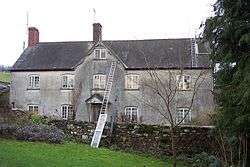Tregeiriog House, Llanishen, Monmouthshire
| Tregeiriog House | |
|---|---|
 "Graded II* for the special interest of its interiors, including the exceptional vaulted cellars." | |
| Type | House |
| Location | Llanishen, Monmouthshire |
| Coordinates | 51°43′58″N 2°47′24″W / 51.7329°N 2.7901°WCoordinates: 51°43′58″N 2°47′24″W / 51.7329°N 2.7901°W |
| Built | C.16th-17th centuries |
| Architectural style(s) | Vernacular |
| Governing body | Privately owned |
Listed Building – Grade II* | |
| Official name: Tregeiriog Farmhouse | |
| Designated | 26 March 1993 |
| Reference no. | 2885 |
 Location of Tregeiriog House in Monmouthshire | |
Tregeiriog House, Llanishen, Monmouthshire is a farmhouse dating from the late 16th or early 17th centuries. Enlarged in the late 17th century, it was remodelled in the mid-18th century, when it was the home of the Duke of Beaufort's local agent. Still a private residence, it is a Grade II* listed building.
History
The present house has origins in the late 16th or early 17th century,[1] although there is evidence of earlier occupation.[2] In 1749, the farm was owned by Daniel Tregose, Sheriff of Monmouthshire in 1756.[3] The architectural historian John Newman notes that the house was the home to the Duke of Beaufort's agent in the mid-18th century.[4] By the 20th century the house was in a state of complete dilapidation, but a significant repair programme commenced in 2012.[2] The cellars of the house are home to a colony of Lesser horseshoe bats and are designated a Site of Special Scientific Interest (SSSI).[2]
Architecture and description
John Newman considers the oldest part of the house to be the rear cross-wing.[4] Cadw suggests that the five-bay frontage was added in the mid-18th century, intended to unify the appearance of the house. Newman calls it a, "typical 18th century manoeuvre".[4] The interior was significantly remodelled at the same time, and Cadw considers that the extensive cellars were constructed during this remodelling.[1]
Notes
- 1 2 "Listed Buildings - Full Report - HeritageBill Cadw Assets - Reports". cadwpublic-api.azurewebsites.net.
- 1 2 3 http://idox.monmouthshire.gov.uk/WAM/doc/Other-292029.pdf?extension=.pdf&id=292029&appid=1001&location=volume4&contentType=application/pdf&pageCount=1
- ↑ https://www.thegazette.co.uk/London/issue/9549/page/1
- 1 2 3 Newman 2000, p. 323.
References
- Newman, John (2000). Gwent/Monmouthshire. The Buildings of Wales. London: Penguin. ISBN 0-14-071053-1.